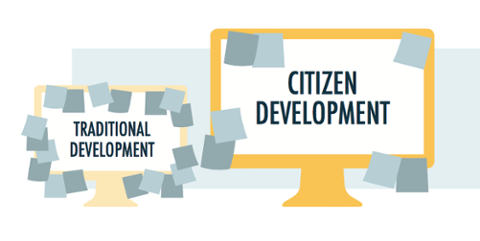 One of the technology industry’s longest-standing issues is the tension between professional developers and the organizations they serve. When either side feels poorly served by the other, it leads to too many application-development projects either delayed or canceled outright. Many business executives have a hard time describing how they want an application to actually function. Factor in the tools that developers use to build those applications, and you have a real issue. Every change to the application during the development process usually results in additional weeks of programming, driving business executives to distraction. The end result is often a backlog of applications that gets longer with each passing day. Thanks to that exasperation, more end-users are taking matters into their own hands and developing their own applications, using tools that make it possible to rapidly stitch together software components into a finished app. There is a lot of debate over the wisdom of enabling a new class of “citizen developers,” but the fact remains that more organizations than ever want to end-run around what they perceive as a professional-developer bottleneck. “We just had a horrible experience using professional developers,” said Marc Lehane, senior business developer with BDP International, a provider of logistics and transportation services. “Now we can develop everything much faster on our own.” For professional developers, this shift in development responsibilities creates some conflict. On one hand, the more applications developed by citizen developers, the less theoretical demand there is for their services. On the other, given the shortage of professional developers, the only viable way to reduce an industry-wide backlog is to find creative ways to increase the available pool of talent. That means empowering end users to build applications that many professional developers might view as being either routine or too trivial to be worth their time and effort. In fact, providers of application development tools such as Salesforce and Mendix have made concerted efforts to create ecosystems that bring professional and citizen developers together. At a Salesforce TrailheaDX 2016 conference last week, Salesforce hosted citizen and professional developers side by side, even going so far as to extend a program through which many citizen developers can be accredited. Dylan Steele, senior director of product marketing for App Cloud & IoT Cloud at Salesforce, thinks there is a direct correlation between the size of the Salesforce developer community and consumption of its services. For that reason, the company provides declarative programming tools that are more accessible to end-users. “We’re trying to fill the gap in developer skills,” Steele said. “Organizations can choose to write code or make use of our declarative tools to create applications.” Also last week, Mendix hosted a Mendix World 2016 conference during which it announced that advanced analytics and machine learning capabilities such as IBM Watson would be soon made available to citizen and professional developers alike. Mendix CEO Derek Roos told attendees that automating application development is crucial to the democratization of IT. “The world’s most powerful technologies are being democratized,” Roos said. “But today it’s taking ages to build a relatively simple experience.” While it’s clear that end-users are going to play a much more active role in the development of those application experiences, the degree to which users will participate in that process is a subject of fierce debate. Speaking at the Mendix World conference, Olu Brown, director of platform engagement for Massachusetts Institute of Technology (MIT), noted that individuals still need a particular set of skills to build applications, no matter what their background. “It still takes a special kind of person to develop an application,” Brown said. “They have to have some kind of technology background.” While MIT is committed to enabling end-users to develop applications on their own, Enexis, a provider of energy services in the Netherlands, is taking a more structured approach. “We’re looking to recruit people from the business into the IT department to become developers,” said Hans Minderhoud, enterprise solutions architect for Enexis. Whatever the ultimate outcome, two things are for certain. One way or another, organizations are going to increase the pool of application developers available to them, which will have an impact on demand for the skills of professional developers. Second, professional developers, while still very much needed, are going to be required to work more hand-in-glove with citizen developers, whether they like it or not.
One of the technology industry’s longest-standing issues is the tension between professional developers and the organizations they serve. When either side feels poorly served by the other, it leads to too many application-development projects either delayed or canceled outright. Many business executives have a hard time describing how they want an application to actually function. Factor in the tools that developers use to build those applications, and you have a real issue. Every change to the application during the development process usually results in additional weeks of programming, driving business executives to distraction. The end result is often a backlog of applications that gets longer with each passing day. Thanks to that exasperation, more end-users are taking matters into their own hands and developing their own applications, using tools that make it possible to rapidly stitch together software components into a finished app. There is a lot of debate over the wisdom of enabling a new class of “citizen developers,” but the fact remains that more organizations than ever want to end-run around what they perceive as a professional-developer bottleneck. “We just had a horrible experience using professional developers,” said Marc Lehane, senior business developer with BDP International, a provider of logistics and transportation services. “Now we can develop everything much faster on our own.” For professional developers, this shift in development responsibilities creates some conflict. On one hand, the more applications developed by citizen developers, the less theoretical demand there is for their services. On the other, given the shortage of professional developers, the only viable way to reduce an industry-wide backlog is to find creative ways to increase the available pool of talent. That means empowering end users to build applications that many professional developers might view as being either routine or too trivial to be worth their time and effort. In fact, providers of application development tools such as Salesforce and Mendix have made concerted efforts to create ecosystems that bring professional and citizen developers together. At a Salesforce TrailheaDX 2016 conference last week, Salesforce hosted citizen and professional developers side by side, even going so far as to extend a program through which many citizen developers can be accredited. Dylan Steele, senior director of product marketing for App Cloud & IoT Cloud at Salesforce, thinks there is a direct correlation between the size of the Salesforce developer community and consumption of its services. For that reason, the company provides declarative programming tools that are more accessible to end-users. “We’re trying to fill the gap in developer skills,” Steele said. “Organizations can choose to write code or make use of our declarative tools to create applications.” Also last week, Mendix hosted a Mendix World 2016 conference during which it announced that advanced analytics and machine learning capabilities such as IBM Watson would be soon made available to citizen and professional developers alike. Mendix CEO Derek Roos told attendees that automating application development is crucial to the democratization of IT. “The world’s most powerful technologies are being democratized,” Roos said. “But today it’s taking ages to build a relatively simple experience.” While it’s clear that end-users are going to play a much more active role in the development of those application experiences, the degree to which users will participate in that process is a subject of fierce debate. Speaking at the Mendix World conference, Olu Brown, director of platform engagement for Massachusetts Institute of Technology (MIT), noted that individuals still need a particular set of skills to build applications, no matter what their background. “It still takes a special kind of person to develop an application,” Brown said. “They have to have some kind of technology background.” While MIT is committed to enabling end-users to develop applications on their own, Enexis, a provider of energy services in the Netherlands, is taking a more structured approach. “We’re looking to recruit people from the business into the IT department to become developers,” said Hans Minderhoud, enterprise solutions architect for Enexis. Whatever the ultimate outcome, two things are for certain. One way or another, organizations are going to increase the pool of application developers available to them, which will have an impact on demand for the skills of professional developers. Second, professional developers, while still very much needed, are going to be required to work more hand-in-glove with citizen developers, whether they like it or not. Time to Make Room for 'Citizen Developers'
 One of the technology industry’s longest-standing issues is the tension between professional developers and the organizations they serve. When either side feels poorly served by the other, it leads to too many application-development projects either delayed or canceled outright. Many business executives have a hard time describing how they want an application to actually function. Factor in the tools that developers use to build those applications, and you have a real issue. Every change to the application during the development process usually results in additional weeks of programming, driving business executives to distraction. The end result is often a backlog of applications that gets longer with each passing day. Thanks to that exasperation, more end-users are taking matters into their own hands and developing their own applications, using tools that make it possible to rapidly stitch together software components into a finished app. There is a lot of debate over the wisdom of enabling a new class of “citizen developers,” but the fact remains that more organizations than ever want to end-run around what they perceive as a professional-developer bottleneck. “We just had a horrible experience using professional developers,” said Marc Lehane, senior business developer with BDP International, a provider of logistics and transportation services. “Now we can develop everything much faster on our own.” For professional developers, this shift in development responsibilities creates some conflict. On one hand, the more applications developed by citizen developers, the less theoretical demand there is for their services. On the other, given the shortage of professional developers, the only viable way to reduce an industry-wide backlog is to find creative ways to increase the available pool of talent. That means empowering end users to build applications that many professional developers might view as being either routine or too trivial to be worth their time and effort. In fact, providers of application development tools such as Salesforce and Mendix have made concerted efforts to create ecosystems that bring professional and citizen developers together. At a Salesforce TrailheaDX 2016 conference last week, Salesforce hosted citizen and professional developers side by side, even going so far as to extend a program through which many citizen developers can be accredited. Dylan Steele, senior director of product marketing for App Cloud & IoT Cloud at Salesforce, thinks there is a direct correlation between the size of the Salesforce developer community and consumption of its services. For that reason, the company provides declarative programming tools that are more accessible to end-users. “We’re trying to fill the gap in developer skills,” Steele said. “Organizations can choose to write code or make use of our declarative tools to create applications.” Also last week, Mendix hosted a Mendix World 2016 conference during which it announced that advanced analytics and machine learning capabilities such as IBM Watson would be soon made available to citizen and professional developers alike. Mendix CEO Derek Roos told attendees that automating application development is crucial to the democratization of IT. “The world’s most powerful technologies are being democratized,” Roos said. “But today it’s taking ages to build a relatively simple experience.” While it’s clear that end-users are going to play a much more active role in the development of those application experiences, the degree to which users will participate in that process is a subject of fierce debate. Speaking at the Mendix World conference, Olu Brown, director of platform engagement for Massachusetts Institute of Technology (MIT), noted that individuals still need a particular set of skills to build applications, no matter what their background. “It still takes a special kind of person to develop an application,” Brown said. “They have to have some kind of technology background.” While MIT is committed to enabling end-users to develop applications on their own, Enexis, a provider of energy services in the Netherlands, is taking a more structured approach. “We’re looking to recruit people from the business into the IT department to become developers,” said Hans Minderhoud, enterprise solutions architect for Enexis. Whatever the ultimate outcome, two things are for certain. One way or another, organizations are going to increase the pool of application developers available to them, which will have an impact on demand for the skills of professional developers. Second, professional developers, while still very much needed, are going to be required to work more hand-in-glove with citizen developers, whether they like it or not.
One of the technology industry’s longest-standing issues is the tension between professional developers and the organizations they serve. When either side feels poorly served by the other, it leads to too many application-development projects either delayed or canceled outright. Many business executives have a hard time describing how they want an application to actually function. Factor in the tools that developers use to build those applications, and you have a real issue. Every change to the application during the development process usually results in additional weeks of programming, driving business executives to distraction. The end result is often a backlog of applications that gets longer with each passing day. Thanks to that exasperation, more end-users are taking matters into their own hands and developing their own applications, using tools that make it possible to rapidly stitch together software components into a finished app. There is a lot of debate over the wisdom of enabling a new class of “citizen developers,” but the fact remains that more organizations than ever want to end-run around what they perceive as a professional-developer bottleneck. “We just had a horrible experience using professional developers,” said Marc Lehane, senior business developer with BDP International, a provider of logistics and transportation services. “Now we can develop everything much faster on our own.” For professional developers, this shift in development responsibilities creates some conflict. On one hand, the more applications developed by citizen developers, the less theoretical demand there is for their services. On the other, given the shortage of professional developers, the only viable way to reduce an industry-wide backlog is to find creative ways to increase the available pool of talent. That means empowering end users to build applications that many professional developers might view as being either routine or too trivial to be worth their time and effort. In fact, providers of application development tools such as Salesforce and Mendix have made concerted efforts to create ecosystems that bring professional and citizen developers together. At a Salesforce TrailheaDX 2016 conference last week, Salesforce hosted citizen and professional developers side by side, even going so far as to extend a program through which many citizen developers can be accredited. Dylan Steele, senior director of product marketing for App Cloud & IoT Cloud at Salesforce, thinks there is a direct correlation between the size of the Salesforce developer community and consumption of its services. For that reason, the company provides declarative programming tools that are more accessible to end-users. “We’re trying to fill the gap in developer skills,” Steele said. “Organizations can choose to write code or make use of our declarative tools to create applications.” Also last week, Mendix hosted a Mendix World 2016 conference during which it announced that advanced analytics and machine learning capabilities such as IBM Watson would be soon made available to citizen and professional developers alike. Mendix CEO Derek Roos told attendees that automating application development is crucial to the democratization of IT. “The world’s most powerful technologies are being democratized,” Roos said. “But today it’s taking ages to build a relatively simple experience.” While it’s clear that end-users are going to play a much more active role in the development of those application experiences, the degree to which users will participate in that process is a subject of fierce debate. Speaking at the Mendix World conference, Olu Brown, director of platform engagement for Massachusetts Institute of Technology (MIT), noted that individuals still need a particular set of skills to build applications, no matter what their background. “It still takes a special kind of person to develop an application,” Brown said. “They have to have some kind of technology background.” While MIT is committed to enabling end-users to develop applications on their own, Enexis, a provider of energy services in the Netherlands, is taking a more structured approach. “We’re looking to recruit people from the business into the IT department to become developers,” said Hans Minderhoud, enterprise solutions architect for Enexis. Whatever the ultimate outcome, two things are for certain. One way or another, organizations are going to increase the pool of application developers available to them, which will have an impact on demand for the skills of professional developers. Second, professional developers, while still very much needed, are going to be required to work more hand-in-glove with citizen developers, whether they like it or not. 


